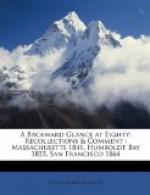The nearest settlement was the Russian colony near Bodega, one hundred and seventy-five miles to the south. In 1811 Kuskoff found a river entering the ocean near the point. He called it Slavianski, but General Vallejo rescued us from that when he referred to it as Russian River. The land was bought from the Indians for a trifle. Madrid was applied to for a title, but the Spaniards declined to give it. The Russians held possession, however, and proceeded with cultivation. To better protect their claims, nineteen miles up the coast, they erected a stockade mounting twenty guns. They called the fort Kosstromitinoff, but the Spaniards referred to it as el fuerte de los Rusos, which was anglicized as Fort Russ, and, finally, as Fort Ross. The colony prospered for a while, but sealing “pinched out” and the territory occupied was too small to satisfy agricultural needs. In 1841 the Russians sold the whole possession to General Sutter for thirty thousand dollars and withdrew from California, returning to Alaska.
In 1827 a party of adventurers started north from Fort Ross for Oregon, following the coast. One Jedidiah Smith, a trapper, was the leader. It is said that Smith River, near the Oregon line, was named for him. Somewhere on the way all but four were reported killed by the Indians. They are supposed to have been the first white men to enter the Humboldt country.
Among the very early settlers in California was Pearson B. Redding, who lived on a ranch near Mount Shasta. In 1845, on a trapping expedition, he struck west through a divide in the Coast Range and discovered a good-sized, rapid river flowing to the west. From its direction and the habit of rivers to seek the sea, he concluded that it was likely to reach the Pacific at about the latitude of Trinidad, named seventy years before. He thereupon gave it the name of Trinity, and in due time left it running and returned to his home.
Three years passed, and gold was discovered by Marshall. Redding was interested and curious and visited the scene of Marshall’s find. The American River and its bars reminded him of the Trinity, and when he returned to his home he organized a party to prospect it. Gold was found in moderate quantities, especially on the upper portions. The Trinity mines extended confidence and added to the excitement. Camps sprang up on every bar. The town of Weaverville took the lead, and still holds it. Quite a population followed and the matter of provisioning it became serious. The base of supplies was Sacramento, two hundred miles distant and over a range of mountains. To the coast it could not be more than seventy miles. If the Trinity entered a bay or was navigable, it would be a great saving and of tremendous advantage. The probability or possibility was alluring and was increasingly discussed.




